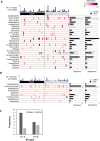Higher abundance of enterovirus A species in the gut of children with islet autoimmunity
- PMID: 30741981
- PMCID: PMC6370883
- DOI: 10.1038/s41598-018-38368-8
Higher abundance of enterovirus A species in the gut of children with islet autoimmunity
Abstract
Enteroviruses (EVs) are prime candidate environmental triggers of islet autoimmunity (IA), with potential as vaccine targets for type 1 diabetes prevention. However, the use of targeted virus detection methods and the selective focus on EVs by most studies increases the risk for substantial investigation bias and an overestimated association between EV and type 1 diabetes. Here we performed comprehensive virome-capture sequencing to examine all known vertebrate-infecting viruses without bias in 182 specimens (faeces and plasma) collected before or at seroconversion from 45 case children with IA and 48 matched controls. From >2.6 billion reads, 28 genera of viruses were detected and 62% of children (58/93) were positive for ≥1 vertebrate-infecting virus. We identified 129 viruses as differentially abundant between the gut of cases and controls, including 5 EV-A types significantly more abundant in the cases. Our findings further support EV's hypothesised contribution to IA and corroborate the proposal that viral load may be an important parameter in disease pathogenesis. Furthermore, our data indicate a previously unrecognised association of IA with higher EV-A abundance in the gut of children and provide a catalog of viruses to be interrogated further to determine a causal link between virus infection and type 1 diabetes.
Conflict of interest statement
The authors declare no competing interests.
Figures



References
Publication types
MeSH terms
LinkOut - more resources
Full Text Sources
Medical
Molecular Biology Databases

